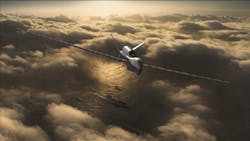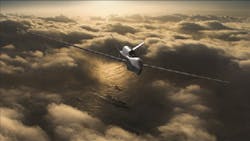Navy beefs-up wide-area ocean surveillance with orders for more Triton UAVs
PATUXENT RIVER NAS, Md. - Officials of the Naval Air Systems Command at Patuxent River Naval Air Station, Md., have announced a $255.3 million order to the Northrop Grumman Aerospace Systems sector in San Diego for three MQ-4C Triton long-range and long-endurance unmanned aerial vehicles (UAVs) for real-time intelligence, surveillance, and reconnaissance (ISR) over vast ocean and coastal regions. The three low-rate initial production UAVs are part of the third lot of Triton production.
The U.S. Navy is using large long-endurance unmanned aircraft for maritime patrol and surveillance missions.
Northrop Grumman is building the Triton, also called Broad Area Maritime Surveillance (BAMS), to fly maritime surveillance missions lasting 24 hours at altitudes of more than 10 miles to enable coverage out to 2,000 nautical miles. The UAV's suite of sensors can detect and classify different types of surface ships automatically. The Triton will be a crucial component of the Navy's 21st century strategy for conducting surveillance of surface ship and submarine traffic in oceans around the globe.
The Triton's maritime search radar, the Northrop Grumman AN/ZPY-3 Multi-Function Active Sensor (MFAS), will provide a 360-degree view of a large maritime area while providing all-weather coverage for detecting, classifying, tracking, and identifying surface ships and other targets of interest. MFAS is separate from the Triton's air-to-air radar. The MFAS radar first flew on the Triton during testing in April 2015.
Along with the air-to-air and MFAS radar systems, the MQ-4C will carry an electro-optical/infrared (EO/IR) sensor that will provide still imagery and full-motion video of potential threats; an electronic support measures package to identify and geolocate radar threat signals; and an automatic identification system (AIS) that will detect and track vessels equipped with AIS responders.
The Navy took delivery of the first operational MQ-4C unmanned aircraft last November at Point Mugu Naval Air Station, Calif. The MQ-4C Triton is designed to provide combat information to military authorities like the expeditionary strike group, carrier strike group, and the joint forces maritime component commander. The Triton is based on the U.S. Air Force RQ-4B Global Hawk. The Triton feeds intelligence, surveillance, and reconnaissance (ISR) data to the Global Information Grid (GIG), and can work alone or together with other aircraft and surface ships.
Triton aircraft and support facilities are based domestically at Point Mugu Naval Air Station near Ventura, Calif., and at Mayport Naval Station near Jacksonville, Fla. Triton UAVs also will be forward-deployed to Andersen Air Force Base, Guam; Sigonella Naval Air Station, Italy; and with the Navy's Fifth Fleet based in Bahrain in the Middle East.
For more information visit Northrop Grumman online at www.northropgrumman.com.

